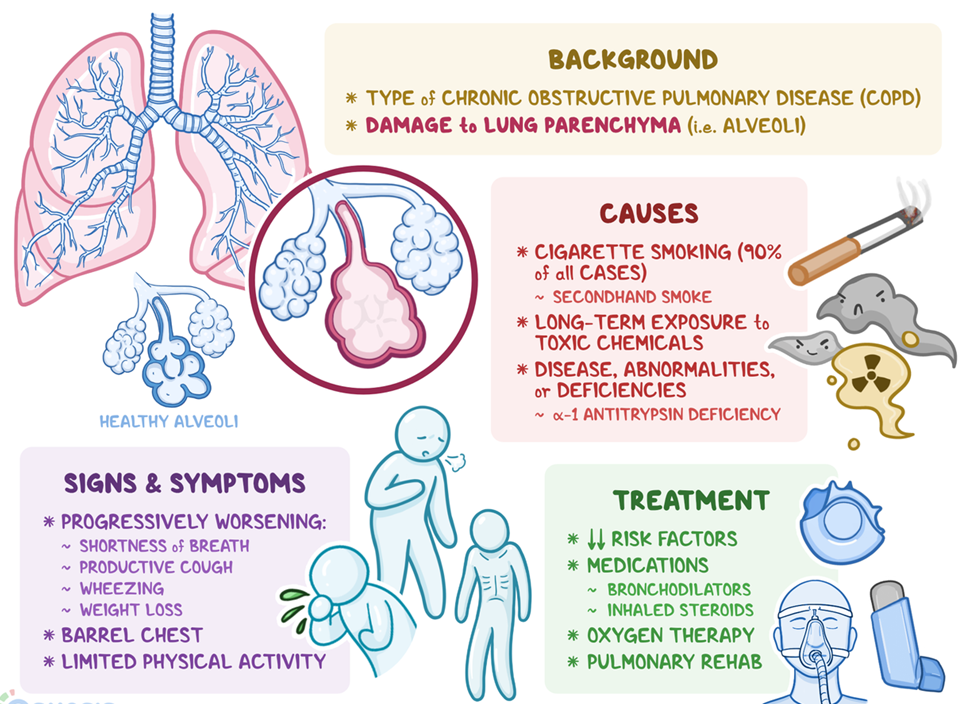A nurse is collecting data from a client who has emphysema. Which of the following findings should the nurse expect? (Select all that apply.)
Dyspnea
Barrel chest
Clubbing of the fingers
Shallow respirations
Bradycardia
Correct Answer : A,B,D
A. Dyspnea: Dyspnea is a hallmark symptom of emphysema. As lung function deteriorates, the client experiences difficulty breathing, especially during exertion, due to reduced gas exchange and air trapping in the lungs.
B. Barrel chest: A barrel chest is a common finding in emphysema due to hyperinflation of the lungs over time. This causes the chest to become rounded and expands the anterior-posterior diameter of the thorax.
C. Clubbing of the fingers: Clubbing of the fingers is not a typical finding in emphysema or COPD. It is more commonly associated with conditions like lung cancer, cystic fibrosis, or congenital heart disease, where chronic severe hypoxia is present.
D. Shallow respirations: Clients with emphysema often exhibit shallow respirations as their lung elasticity decreases, making it difficult to fully exhale. As a result, breathing may become more rapid and shallow to compensate for poor oxygen exchange.
E. Bradycardia: Bradycardia is not typically associated with emphysema. Instead, clients with chronic respiratory conditions like emphysema may experience tachycardia as the body tries to compensate for low oxygen levels.

Nursing Test Bank
Naxlex Comprehensive Predictor Exams
Related Questions
Correct Answer is ["B"]
Explanation
A. 24-year-old woman with allergic rhinitis:
Likely safe to take an alpha-adrenergic decongestant as allergic rhinitis is a common indication for decongestant use in young, healthy individuals.
B. 18-year-old man with cold symptoms:
Likely safe to take an alpha-adrenergic decongestant as it's a common indication for decongestant use in young, healthy individuals.
C. 64-year-old woman with a history of heart disease:
Should avoid alpha-adrenergic decongestants due to the risk of increasing blood pressure and potentially worsening heart conditions.
D. 70-year-old woman with glaucoma:
Should avoid alpha-adrenergic decongestants due to the risk of exacerbating glaucoma by causing pupil dilation and increasing intraocular pressure.
E. 56-year-old man with prostatic hypertrophy:
Should avoid alpha-adrenergic decongestants due to the risk of worsening urinary symptoms caused by prostatic hypertrophy, such as urinary retention.
Correct Answer is A
Explanation
A. Start slowly and increase volume over several sessions.
This is the correct choice. For clients having difficulty using an incentive spirometer, starting slowly and gradually increasing the volume over several sessions is an appropriate approach. It allows the client to become familiar with the device and the technique required for effective use. Starting slowly also reduces the risk of discomfort or respiratory distress, allowing the client to build up their lung capacity gradually and achieve optimal results over time.
B. Do regular deep-breathing exercises instead.
Regular deep-breathing exercises are beneficial for improving lung function and respiratory strength. However, using an incentive spirometer serves a specific purpose in promoting deep breathing and lung expansion to prevent atelectasis (lung collapse) and improve respiratory function. While deep-breathing exercises are helpful, they may not provide the same targeted benefits as using an incentive spirometer, especially for clients who are experiencing difficulty with deep breathing or lung expansion.
C. Use another device because this one might be faulty.
This option assumes that the difficulty with the incentive spirometer is due to a fault in the device itself, which may not necessarily be the case. Before considering another device, it's important to ensure that the client is using the current device correctly and receiving proper instruction. If the client continues to have difficulty despite proper technique and instruction, then further assessment of the device may be warranted.
D. Be much more vigorous in increasing increments.
Being much more vigorous in increasing increments is not recommended, as it could lead to discomfort, respiratory distress, or hyperventilation for the client. Increasing the volume too quickly may overwhelm the client and make it more difficult for them to use the incentive spirometer effectively. Gradual progression allows the client to adjust to the device and build up their lung capacity safely and effectively over time.
Whether you are a student looking to ace your exams or a practicing nurse seeking to enhance your expertise , our nursing education contents will empower you with the confidence and competence to make a difference in the lives of patients and become a respected leader in the healthcare field.
Visit Naxlex, invest in your future and unlock endless possibilities with our unparalleled nursing education contents today
Report Wrong Answer on the Current Question
Do you disagree with the answer? If yes, what is your expected answer? Explain.
Kindly be descriptive with the issue you are facing.
